.gif)
El Toro (roller coaster)
Encyclopedia
El Toro, meaning The Bull in Spanish
, is a wooden
roller coaster
at Six Flags Great Adventure
. It opened to the public on June 11, 2006. It was designed by Intamin of Switzerland
. It had the steepest drop of any wooden roller coaster in the world, at 76 degrees, until this record was broken by T Express
in 2008 by 1 degree. It is the third tallest (188 ft; 57 m) and third fastest (70 mph; 113 km/h) wooden roller coaster in the world. It is also the first wooden roller coaster to use a cable lift hill instead of the traditional chain lift
. Because of the extreme negative g-forces
(airtime) on the ride, the lap-bar restraints are very tight, causing some problems for older and larger riders.
El Toro is the main attraction of a new Mexican-themed section, Plaza Del Carnaval. Some of the ride's track is located in Rolling Thunder
's infield. It is the steepest lifted (as opposed to launched) roller coaster in the park.
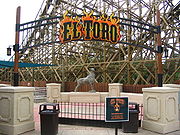 Once the first car of the train is past the catch-car, the cable begins moving and the catch-car locks onto the first car. As soon as the entire train is on the lift, the cable accelerates to its full speed of 13.5 mph (21.7 km/h). At this speed, it takes about 15 seconds for the train to reach the top of the lift. The cable slows down slightly as the train crests the lift, but this is barely noticeable on the ride. The cable continues to pull the train until the entire train is over the top of the lift.
Once the first car of the train is past the catch-car, the cable begins moving and the catch-car locks onto the first car. As soon as the entire train is on the lift, the cable accelerates to its full speed of 13.5 mph (21.7 km/h). At this speed, it takes about 15 seconds for the train to reach the top of the lift. The cable slows down slightly as the train crests the lift, but this is barely noticeable on the ride. The cable continues to pull the train until the entire train is over the top of the lift.
After cresting the top of the lift (in which some airtime could be felt before the lift was slowed down in 2007), the train briefly travels forward and makes a sharp 180 degree turn as it quickly picks up speed. It then drops 176 ft (54 m) at a 76 degree angle. The train reaches 70 mph (110 km/h); however, according to some ride operators the ride runs faster than it should, around 75 mph (120 km/h). Some people say that it feels like the train is being dragged down the first drop. The drop is noted as one of the best drops on any coaster because of its pull and feeling of the world dropping-out from beneath the rider. The drop is experienced very differently in each row because of the length of the train. The front row hangs over the drop for quite a long time, the train only starting to really pick up speed when the front row is almost at the steepest part of the drop. In the back row, the train picks up speed upon reaching the end of the turn before the drop, resulting in strong ejector air that's sustained almost all the way down the drop.
As the train reaches the bottom of the drop it comes close to the track above it creating a headchopper-effect. It then speeds up and over a 112 ft (34 m) hill where riders experience strong and extreme air-time. After going down the hill riders have their picture taken and then go up and crest a 100 ft (30 m) hill, once again with strong ejector air. As it comes out of the hill more headchoppers are speedily passed as it the shoots up an 82 ft (25 m) hill, giving less intense ejector airtime. The train speeds into a sharp 180 degree downward-banked turn and up another banked turn and then drops, this time riders experience floater airtime. The train goes through more headchoppers and a small 2nd hill that speeds past the station and the lakeside. The ride then makes another turn and up a smaller hill over Rolling Thunder. After coming down the drop, the ride snakes through twists and turns through Rolling Thunder's infield. After coming out of the twister section, the train slows down as it moves through small S turn hills and into the brake run.
because it is a prefabricated wooden roller coaster. This means that instead of trackers cutting, shaping, and laying down the track on site by hand, the track is laser cut in a factory. This means that the track is manufactured to a higher degree of precision than could ever be achieved by hand. The track is also made so that it snaps together like Lego
pieces and is made of more layers of wood that are tightly bonded together instead of nailed together by hand like a traditional wooden roller coaster. This has three major benefits, two being to the park and the other being to the riders. The "Plug and Play" aspect of the coaster speeds construction of the coaster since track does not have to be completely manufactured on site. In addition, because of the speed of construction, the costs of building the coaster are lowered due to fewer manhours spent on the construction. The riders are subject to a coaster that is as smooth as steel. Some roller coaster enthusiasts argue that this takes away from the ride since it lacks the character of a traditional wooden roller coaster. Others appreciate its incredible airtime. El Toro is the first Intamin "Plug and Play" wooden roller coaster in the United States. The other three are Colossos
at Heide Park
in Germany
, Balder
at Liseberg
in Sweden
, and T Express
at Everland
in South Korea
.
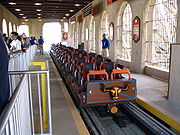 El Toro has several similarities to Viper
El Toro has several similarities to Viper
, the coaster that it replaced. The most obvious similarity is that El Toro uses Viper's station, the only part of Viper that was not torn down. The station previously held two Viper trains at once, with a loading platform in the front and an unloading platform in the rear. The ramp that was previously Viper's main exit is now used only for wheelchair access, as El Toro has a new exit on the other side of the station. During El Toro's construction, the station was gutted and an entirely new platform built. Like El Toro, Viper turned left out of the station before the lift hill and turned left at the top of the lift before the first drop. El Toro's entrance uses an iron arch that is very similar to the one used for Viper's entrance, but a good deal wider.
El Toro's on-ride camera
is located at the bottom of the second drop. It takes a single, vertically oriented picture of each of the 6 cars. Those who intend to purchase their photo are advised to sit in the front row of any car.
El Toro is most known for its relentless speed, its very steep first drop, the cable lift, smoothness, headchoppers, and its intense sensations of ejector airtime.
El Toro normally remains open in the rain (but not during a thunderstorm
). However, intense or sustained rainfall can get the drive tires before the station wet enough that a train approaching the station will sometimes slip over them, causing the ride to shut itself down for safety reasons. While this situation is normally resolved in a matter of minutes, the guests on the train approaching the station will be stuck in the rain until the train in the station can be dispatched and their train advanced into the station.
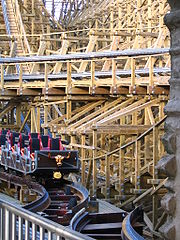 El Toro has two trains
El Toro has two trains
, each seating 36 passengers (3 rows of 2 passengers per car, 6 cars per train), the second longest trains in the park. El Toro has a capacity of 1200 guests per hour. The trains are simply known as "Train A" (light brown) and "Train B" (dark brown), although they have been nicknamed "Jorge" (Pronounced Or-Hay) (Train A) and "Hector" (Train B) by the ride operators. The trains have padded "wings" at shoulder level to prevent riders from being thrown too far to the side in the final twister section. These wings were originally made of plastic, but were replaced by much stronger metal ones after several of them broke in the middle of El Toro's opening season. A pair of the original plastic wings can still be found on the test seat.
El Toro's restraints are very sensitive, which can sometimes result in a car (or sometimes the entire train) being unlocked and re-checked because one of the restraints was not down far enough to allow the train to be dispatched. Having had prior fatalities in the park, Six Flags' caution is understood. Thus, this ride is not really meant for large or unique body structures, and guests are provided with a test seat prior to boarding.
El Toro's U-shaped lapbar restraints (a safer design than Intamin's usual T-shaped restraints) use a hydraulic locking system, which means they can be pushed down to any position, where they will stay. A ratchet-based restraint, in contrast, only locks at each notch and will often be too loose or uncomfortably tight. It also utilizes magnetic brakes—the brake fins are mounted to the underside of the train and the braking magnets are mounted to the track.
El Toro is unusual in that, because of space restrictions, it does not have a garage for its trains. Instead, it has a single open-air storage track, and the other train is stored in the station or brake run. When on the storage track, the train rests on its upstop wheels (the wheels that run under the track to keep it from flying off) rather than its main wheels. This allows for easier maintenance of the main wheels.
As of 2010, the "Hector" train has been re-themed to endorse Stride Gum
, making it one of three coasters in the park to have trains endorsing products. The train was re-painted, showing a different flavor of Stride gum on each car.
and Cyclone
at Astroland
.
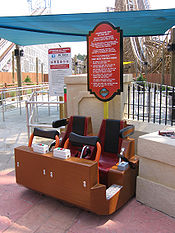
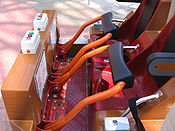 El Toro recently received a test seat, located in the entrance plaza, a welcome addition because of the restraint system's sensitivity to larger guests. The test seat (which is actually two seats) is an exact replica of the front row of one of the cars. It has fully functional, hydraulic-locking restraints, identical to those on the trains.
El Toro recently received a test seat, located in the entrance plaza, a welcome addition because of the restraint system's sensitivity to larger guests. The test seat (which is actually two seats) is an exact replica of the front row of one of the cars. It has fully functional, hydraulic-locking restraints, identical to those on the trains.
In addition to the lapbar restraints, the test seat includes the seatbelts used on the ride. When fastened, they must be pulled tight enough so that the yellow line is visible. If they cannot be pulled this tight, the guest will not be able to ride.
Spanish language
Spanish , also known as Castilian , is a Romance language in the Ibero-Romance group that evolved from several languages and dialects in central-northern Iberia around the 9th century and gradually spread with the expansion of the Kingdom of Castile into central and southern Iberia during the...
, is a wooden
Wooden roller coaster
A wooden roller coaster is most often classified as a roller coaster with laminated steel running rails overlaid upon a wooden track. Occasionally, the structure may be made out of a steel lattice or truss, but the ride remains classified as a wooden roller coaster due to the track design...
roller coaster
Roller coaster
The roller coaster is a popular amusement ride developed for amusement parks and modern theme parks. LaMarcus Adna Thompson patented the first coasters on January 20, 1885...
at Six Flags Great Adventure
Six Flags Great Adventure
Six Flags Great Adventure is a theme park in Jackson Township, New Jersey, owned by Six Flags Entertainment Corp., the world's largest amusement park corporation...
. It opened to the public on June 11, 2006. It was designed by Intamin of Switzerland
Switzerland
Switzerland name of one of the Swiss cantons. ; ; ; or ), in its full name the Swiss Confederation , is a federal republic consisting of 26 cantons, with Bern as the seat of the federal authorities. The country is situated in Western Europe,Or Central Europe depending on the definition....
. It had the steepest drop of any wooden roller coaster in the world, at 76 degrees, until this record was broken by T Express
T Express
T Express is a wooden roller coaster at Everland in Yongin, South Korea. It is South Korea's first wooden coaster, Intamin's fourth wooden coaster with prefabricated track, the first ride of this type in Asia, and the first to utilize three trains. It is currently the world's steepest wooden...
in 2008 by 1 degree. It is the third tallest (188 ft; 57 m) and third fastest (70 mph; 113 km/h) wooden roller coaster in the world. It is also the first wooden roller coaster to use a cable lift hill instead of the traditional chain lift
Lift hill
A lift hill, or chain hill, is often the initial upward-sloping section of track on a typical roller coaster that initially transports the roller coaster train to an elevated point or peak in the roller coaster ride...
. Because of the extreme negative g-forces
G-force
The g-force associated with an object is its acceleration relative to free-fall. This acceleration experienced by an object is due to the vector sum of non-gravitational forces acting on an object free to move. The accelerations that are not produced by gravity are termed proper accelerations, and...
(airtime) on the ride, the lap-bar restraints are very tight, causing some problems for older and larger riders.
El Toro is the main attraction of a new Mexican-themed section, Plaza Del Carnaval. Some of the ride's track is located in Rolling Thunder
Rolling Thunder (roller coaster)
Rolling Thunder is a racing wooden roller coaster at Six Flags Great Adventure in Jackson, NJ. Rolling Thunder is the park's first wooden coaster, and debuted in 1979 during the park's fifth anniversary season. The line for the ride begins at an adjoining entrance and has separate queues for each...
's infield. It is the steepest lifted (as opposed to launched) roller coaster in the park.
Theme
El Toro's name means "The bull" in Spanish, which is what the ride's theme is. The cars are themed as "bulls", and riders are bull riders who attempt to stay on the bull as it tries to buck and throw them off. The name is well-suited to the ride, which is filled with ejector airtime which gives the illusion that one will fly off the ride. The ride's queue is surrounded by the Southwestern-style buildings of Plaza del Carnaval, and also has abandoned "wagon wheels" and Spanish posters along a wall separating the queue from the actual ride.Ride Experience

After cresting the top of the lift (in which some airtime could be felt before the lift was slowed down in 2007), the train briefly travels forward and makes a sharp 180 degree turn as it quickly picks up speed. It then drops 176 ft (54 m) at a 76 degree angle. The train reaches 70 mph (110 km/h); however, according to some ride operators the ride runs faster than it should, around 75 mph (120 km/h). Some people say that it feels like the train is being dragged down the first drop. The drop is noted as one of the best drops on any coaster because of its pull and feeling of the world dropping-out from beneath the rider. The drop is experienced very differently in each row because of the length of the train. The front row hangs over the drop for quite a long time, the train only starting to really pick up speed when the front row is almost at the steepest part of the drop. In the back row, the train picks up speed upon reaching the end of the turn before the drop, resulting in strong ejector air that's sustained almost all the way down the drop.
As the train reaches the bottom of the drop it comes close to the track above it creating a headchopper-effect. It then speeds up and over a 112 ft (34 m) hill where riders experience strong and extreme air-time. After going down the hill riders have their picture taken and then go up and crest a 100 ft (30 m) hill, once again with strong ejector air. As it comes out of the hill more headchoppers are speedily passed as it the shoots up an 82 ft (25 m) hill, giving less intense ejector airtime. The train speeds into a sharp 180 degree downward-banked turn and up another banked turn and then drops, this time riders experience floater airtime. The train goes through more headchoppers and a small 2nd hill that speeds past the station and the lakeside. The ride then makes another turn and up a smaller hill over Rolling Thunder. After coming down the drop, the ride snakes through twists and turns through Rolling Thunder's infield. After coming out of the twister section, the train slows down as it moves through small S turn hills and into the brake run.
Construction
El Toro is very different from a traditional wooden roller coasterWooden roller coaster
A wooden roller coaster is most often classified as a roller coaster with laminated steel running rails overlaid upon a wooden track. Occasionally, the structure may be made out of a steel lattice or truss, but the ride remains classified as a wooden roller coaster due to the track design...
because it is a prefabricated wooden roller coaster. This means that instead of trackers cutting, shaping, and laying down the track on site by hand, the track is laser cut in a factory. This means that the track is manufactured to a higher degree of precision than could ever be achieved by hand. The track is also made so that it snaps together like Lego
Lego
Lego is a line of construction toys manufactured by the Lego Group, a privately held company based in Billund, Denmark. The company's flagship product, Lego, consists of colorful interlocking plastic bricks and an accompanying array of gears, minifigures and various other parts...
pieces and is made of more layers of wood that are tightly bonded together instead of nailed together by hand like a traditional wooden roller coaster. This has three major benefits, two being to the park and the other being to the riders. The "Plug and Play" aspect of the coaster speeds construction of the coaster since track does not have to be completely manufactured on site. In addition, because of the speed of construction, the costs of building the coaster are lowered due to fewer manhours spent on the construction. The riders are subject to a coaster that is as smooth as steel. Some roller coaster enthusiasts argue that this takes away from the ride since it lacks the character of a traditional wooden roller coaster. Others appreciate its incredible airtime. El Toro is the first Intamin "Plug and Play" wooden roller coaster in the United States. The other three are Colossos
Colossos (roller coaster)
Colossos is a wooden roller coaster at Heide Park in Soltau, Lower Saxony, Germany. It is the first wooden roller coaster to use prefabricated track. Colossos is the tallest and fastest wooden roller coaster in Europe and the tallest running wooden roller coaster in the world...
at Heide Park
Heide Park
The Heide Park Resort is a theme park in Soltau, Lower Saxony. With an overall area of over 850,000 m², it is one of the biggest German amusement parks and the biggest in Northern Germany....
in Germany
Germany
Germany , officially the Federal Republic of Germany , is a federal parliamentary republic in Europe. The country consists of 16 states while the capital and largest city is Berlin. Germany covers an area of 357,021 km2 and has a largely temperate seasonal climate...
, Balder
Balder (roller coaster)
Balder is a wooden roller coaster at the Liseberg amusement park in Gothenburg, Sweden. It opened in 2003 and was an instant success. Balder has twice, 2003 and 2005, been voted Best Wooden Tracked Roller Coaster in the world in a major international - not because it is the biggest or fastest...
at Liseberg
Liseberg
Liseberg is an amusement park located in Gothenburg, Sweden, the park opened in 1923. Liseberg is one of the most visited amusement parks in Scandinavia, attracting around 3 million visitors annually. Among the noteworthy attractions is the wooden roller coaster Balder, voted twice as the Best...
in Sweden
Sweden
Sweden , officially the Kingdom of Sweden , is a Nordic country on the Scandinavian Peninsula in Northern Europe. Sweden borders with Norway and Finland and is connected to Denmark by a bridge-tunnel across the Öresund....
, and T Express
T Express
T Express is a wooden roller coaster at Everland in Yongin, South Korea. It is South Korea's first wooden coaster, Intamin's fourth wooden coaster with prefabricated track, the first ride of this type in Asia, and the first to utilize three trains. It is currently the world's steepest wooden...
at Everland
Everland
-External links:*...
in South Korea
South Korea
The Republic of Korea , , is a sovereign state in East Asia, located on the southern portion of the Korean Peninsula. It is neighbored by the People's Republic of China to the west, Japan to the east, North Korea to the north, and the East China Sea and Republic of China to the south...
.

Viper (Six Flags Great Adventure)
Viper was a TOGO mega heartline roller coaster at Six Flags Great Adventure. Viper was closed at the end of 2004 and was demolished in June 2005 for several reasons and was replaced with El Toro....
, the coaster that it replaced. The most obvious similarity is that El Toro uses Viper's station, the only part of Viper that was not torn down. The station previously held two Viper trains at once, with a loading platform in the front and an unloading platform in the rear. The ramp that was previously Viper's main exit is now used only for wheelchair access, as El Toro has a new exit on the other side of the station. During El Toro's construction, the station was gutted and an entirely new platform built. Like El Toro, Viper turned left out of the station before the lift hill and turned left at the top of the lift before the first drop. El Toro's entrance uses an iron arch that is very similar to the one used for Viper's entrance, but a good deal wider.
El Toro's on-ride camera
On-ride camera
An on-ride camera is a camera mounted alongside the track of a roller coaster, log flume or other thrill ride that automatically photographs all of the riders on each passing vehicle. They are often mounted at the most intense or fastest part of the ride, resulting in humorously distorted...
is located at the bottom of the second drop. It takes a single, vertically oriented picture of each of the 6 cars. Those who intend to purchase their photo are advised to sit in the front row of any car.
El Toro is most known for its relentless speed, its very steep first drop, the cable lift, smoothness, headchoppers, and its intense sensations of ejector airtime.
El Toro normally remains open in the rain (but not during a thunderstorm
Thunderstorm
A thunderstorm, also known as an electrical storm, a lightning storm, thundershower or simply a storm is a form of weather characterized by the presence of lightning and its acoustic effect on the Earth's atmosphere known as thunder. The meteorologically assigned cloud type associated with the...
). However, intense or sustained rainfall can get the drive tires before the station wet enough that a train approaching the station will sometimes slip over them, causing the ride to shut itself down for safety reasons. While this situation is normally resolved in a matter of minutes, the guests on the train approaching the station will be stuck in the rain until the train in the station can be dispatched and their train advanced into the station.
Trains and station

Train (roller coaster)
A roller coaster train or car describes the vehicle which transports passengers around a roller coaster's circuit. More specifically, a roller coaster train is made up of two or more "cars" which are connected by some sort of specialized joint. It is called a "train" because the cars follow one...
, each seating 36 passengers (3 rows of 2 passengers per car, 6 cars per train), the second longest trains in the park. El Toro has a capacity of 1200 guests per hour. The trains are simply known as "Train A" (light brown) and "Train B" (dark brown), although they have been nicknamed "Jorge" (Pronounced Or-Hay) (Train A) and "Hector" (Train B) by the ride operators. The trains have padded "wings" at shoulder level to prevent riders from being thrown too far to the side in the final twister section. These wings were originally made of plastic, but were replaced by much stronger metal ones after several of them broke in the middle of El Toro's opening season. A pair of the original plastic wings can still be found on the test seat.
El Toro's restraints are very sensitive, which can sometimes result in a car (or sometimes the entire train) being unlocked and re-checked because one of the restraints was not down far enough to allow the train to be dispatched. Having had prior fatalities in the park, Six Flags' caution is understood. Thus, this ride is not really meant for large or unique body structures, and guests are provided with a test seat prior to boarding.
El Toro's U-shaped lapbar restraints (a safer design than Intamin's usual T-shaped restraints) use a hydraulic locking system, which means they can be pushed down to any position, where they will stay. A ratchet-based restraint, in contrast, only locks at each notch and will often be too loose or uncomfortably tight. It also utilizes magnetic brakes—the brake fins are mounted to the underside of the train and the braking magnets are mounted to the track.
El Toro is unusual in that, because of space restrictions, it does not have a garage for its trains. Instead, it has a single open-air storage track, and the other train is stored in the station or brake run. When on the storage track, the train rests on its upstop wheels (the wheels that run under the track to keep it from flying off) rather than its main wheels. This allows for easier maintenance of the main wheels.
As of 2010, the "Hector" train has been re-themed to endorse Stride Gum
Stride (gum)
Stride is a brand of chewing gum created by Cadbury Adams . Its packs usually consist of 14 pieces of gum.-Current Flavors:There are 17 flavors in total.* Always Mandarin* Eternal Melon* Forever Fruit 2.0...
, making it one of three coasters in the park to have trains endorsing products. The train was re-painted, showing a different flavor of Stride gum on each car.
Height restriction notes
Despite predictions by some park employees that the height restriction would be 54 inches (137 cm); Six Flags, Intamin, and the state of New Jersey determined that the height restrictions would be 48 inches (122 cm). This comes as no surprise because virtually every wooden roller coaster has a height restriction of no higher than 48 inches (122 cm) (some even lower). The only restriction on a wooden roller coaster of 54 inches (137 cm) and higher is on Cyclone at Six Flags New EnglandSix Flags New England
Six Flags New England , formerly Riverside Amusement Park, is a Six Flags theme park, named for the New England region, in which it is located. Located off of Massachusetts State Route 159, Six Flags New England is located less than from the major City of Springfield, Massachusetts, in the nearby...
and Cyclone
Coney Island Cyclone
The Coney Island Cyclone is a historic hybrid roller coaster in the Coney Island section of Brooklyn, New York City. On June 18, 1975, Dewey and Jerome Albert, owners of Astroland Park, contracted to operate the Cyclone under an agreement with New York City...
at Astroland
Astroland
Astroland was a amusement park in Coney Island first opened in 1962. It was located at 1000 Surf Avenue on the boardwalk...
.
Test seat


In addition to the lapbar restraints, the test seat includes the seatbelts used on the ride. When fastened, they must be pulled tight enough so that the yellow line is visible. If they cannot be pulled this tight, the guest will not be able to ride.
Awards
| Golden Ticket Awards: Best Wooden Coaster | ||||||
|---|---|---|---|---|---|---|
| Year | 2006 | 2007 | 2008 | 2009 | 2010 | 2011 |
| Ranking | ||||||
| Mitch Hawker's Best Roller Coaster Poll: Best Wooden-Tracked Roller Coaster | |||||
|---|---|---|---|---|---|
| Year | 2006 | 2007 | 2008 | 2009 | 2010 |
| Ranking | |||||

